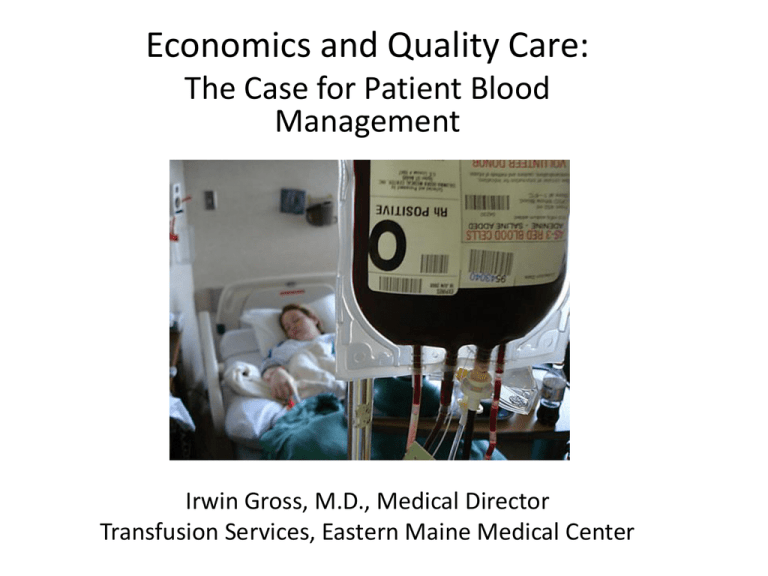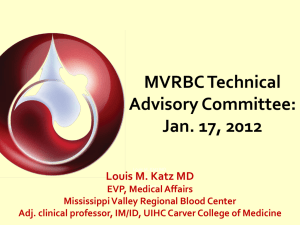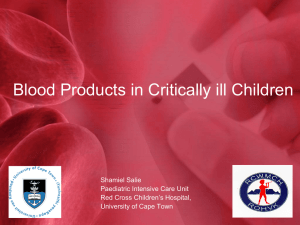
Economics and Quality Care:
The Case for Patient Blood
Management
Why We Should Avoid
Transfusions
Irwin Gross, M.D., Medical Director
Transfusion Services, Eastern Maine Medical Center
Disclosures
• Medical Advisory Board – Strategic Healthcare Group
A little about Eastern Maine Medical Center
• 370 bed community and tertiary care hospital
in rural Maine
• Large hospitalist service
• High risk obstetrics
• Trauma center, Level 2
• Dialysis center
• Family Practice residency
• Cardiac surgery program
– Approx. 450 cases/yr.
• Active heme/onc service
– 10 oncologists
• No transplant surgery
Patient Blood Management (PBM)
The timely application of evidence-based
medical and surgical concepts designed to
maintain hemoglobin concentration,
optimize hemostasis and minimize blood loss
in an effort to improve patient outcome.
What is Patient Blood Management:
The Three Pillars
Optimize
erythropoieis
Minimize
bleeding &
blood loss
© Axel Hofmann/Shannon Farmer –
SHEF Meeting Perth August 2010
Harness &
optimize
physiologic
tolerance of
anemia
Can Patient Blood Management Reduce
the Need for Transfusions?
Red Cell Units Transfused
FY 1994 – FY 2010
9470
Patients Transfused:
FY 1994 - 2011
Patients Transfused
3000
2684
2422 2393 2468
2500
2773
2843
2474
2263
2157
1998
2000
1846 1815
1686
1550
1737
1608
1534
1606
1500
1000
500
FY
94
FY
95
FY
96
FY
97
FY
98
FY
99
FY
00
FY
01
FY
02
FY
03
FY
04
FY
05
FY
06
FY
07
FY
08
FY
09
FY
10
FY
11
0
Transfusion Rates All Cases: CABG, Valve, CABG/Valve
April 2008 – March 2011
Transfusion rate in 2006: 48%
23%
14%
Cardiac Surgery and Transfusions
• With reduction in transfusion rate from
48% to approximately 20% , there was a
reduction in:
–
–
–
–
–
–
Perioperative AMI
New onset renal failure
Perioperative infection
Stroke
Length of stay
No change in mortality
Transfusion Rate: Orthopedics
Blood Transfusion: A Growth Industry
Copyrights 2006 – 2011 Strategic Healthcare Group LLC.
All Rights Reserved
Our Demographic Challenge
• Rapidly increasing
percentage of population
over the age of 65 and
decreasing percentage of
population between 17
and 65
– Decrease in eligible donors
– Increase in population that
are transfusion recipients
– Demand may exceed
supply in the near future
Transfusion is expensive!
Between $832 and $1284
per unit in the EMHS System
Blood and Blood Components:
Cost Savings – All Components (EMMC)
• Total blood acquisition costs in FY ‘06 were $3,200,000
• Cost savings compared to base year, FY ’06*
–
–
–
–
–
–
FY ’07
FY ’08
FY ’09
FY ’10
Total (Acquisition)
Total (ABC)
$ 850,000
$ 1,400,000
$ 1,600,000
$ 1,550,000
$ 5,400,000
$ 17,280,000 **
* No change in per unit cost from blood supplier
from 2007 – 2010
* Using ABC 3.2 times acquisition cost
The Macroeconomic Burden of Transfusion
• Retrospective cohort study by American
College of Medical Quality
• Evaluated all 38.7 million hospitalizations in
U.S. in 2004
• Adjusted for age, gender, comorbidities,
admission type and DRG
• Charges per transfused patient were
$17,194 more than charges for nontransfused, matched patient
• Total excess financial burden: $40 billion
Am J Med Qual 2010;25:289-296
Is Blood Utilization in the U.S. Optimal?
Copyright 2006 – 2011 Strategic Healthcare Group LLC.
All Rights Reserved
Observed Variation in Hospital-Specific Transfusion Rates for
Primary Isolated CABG Surgery With Cardiopulmonary Bypass
During 2008 (N = 798 Sites)
Bennett-Guerrero, E. et al. JAMA 2010;304:1568-1575.
Are Transfusions Safe: Risk vs. Benefit
• The risks of transfusion are increasingly well
defined and extend far beyond concerns about
disease transmission (e.g. HIV, hepatitis)
• The benefits of red cell transfusion, except in
severe hemorrhage, have never been proven
• While anemia is associated with poorer outcomes,
red cell transfusion to treat anemia does not
appear to improve outcomes
Impact of Transfusion on Patient Outcomes
Author (year)
Population
Leal-Novel et al (2001)
Cardiac surgery
Wu et al (2001)
Elderly with MI
Engoren et al (2002)
Cardiac surgery
Vincent et al (2002)
Critically ill
Malone et al (2003)
Trauma
Corwin et al (2004)
Critically ill
Dunne et al (2004)
Trauma
Innerhofer et al (2005)
Orthopedic surgery
Weber et al (2005)
Orthopedic surgery
Koch et al (2006)
Cardiac surgery
n
738
Impact of Blood Transfusion
- Higher mortality rate
- Longer ICU stay
78,974 - Lower 30-day mortality (if admission Hct<33*)
- Higher 30-day mortality (if admission Hct>36)
1,915 - Higher 5-year mortality rate
3,534 - Higher 14- and 28-day mortality rate
15,534 - Higher mortality rate
- More ICU admission
- Longer ICU/hospital stay
4,892 - Higher mortality rate
- Longer length of stay
- More number of complications
9,539 - Higher mortality rate
- More ICU admission
- More SIRS
308
- More infections
695
- Longer time to ambulation
- Longer length of stay
5,841 - More AF
Impact of Transfusion on Patient Outcomes
Author (year)
Koch et al (2005)
Population
Cardiac surgery
Murphy et al (2007)
Cardiac surgery
Surgenor et al (2009)
Cardiac surgery
Pedersen et al (2009)
Total hip
replacement
Nikolsky et al (2009)
PCI after MI
van Straten et al (2010)
Cardiac surgery
D’Ayala et al (2010)
Lower extremity
amputation
O’Keeffe et al (2010)
Lower extremity
revascularization
Veenith et al (2010)
Elderly undergoing
cardiac surgery
n
Impact of Blood Transfusion
11,963 - Higher postop mortality rate
- Higher postop morbidity rate (RF, prolonged ventilatory
support, serious infection, cardiac complications, &
neurologic events)
8,598 - Higher mortality rate
- More ischemic complications
- More infectious complications
3,254 - Decreased survival after cardiac surgery
4,508 - Higher mortality rate
- More pneumonia
2,060 - Higher 30-day and 1-year mortality rate
10,435 - Worse early survival
300
- More postop adverse events
- Longer ICU/hospital stay
8,799 - Higher mortality rate
- More pulmonary complications
- More infectious complications
874
- Higher mortality rate
- Longer ICU/hospital stay
Transfusion and Outcomes
• Following transfusion:
– In all of the studies, Hb increased
– Is this a useful metric of clinical efficacy?
– In 79% of the studies, DO2 increased
– In 16% of the studies, VO2 increased
– In none of the studies, did ischemia (as
measured by lactate) improve
– In all of the studies, transfused patients had
poorer outcomes
Efficacy of RBC Transfusion in the Critically Ill
• Meta-analysis - 45 observational studies of 272,596
patients
• Included surgical (trauma, general, ortho, neuro, and
cardiac) and general ICU patients
• 42 of 45 studies: risks outweighed benefits of
transfusion; risk neutral in 2 studies
• Transfusion an independent risk factor for increased:
•
•
•
•
Mortality
Infection
Multi-organ dysfunction
ARDS
Marik, et al CCM 2008;36:2667-2675
Adverse Effects of Allogeneic Blood
• Storage Lesion
• TRIM
• TRALI: 1 in 2,000 transfusions; primarily
plasma rich products; up to 20% mortality
• Hemolytic transfusion rxns: (1:4,000)
• Bacterial contamination (Plts.-1:75,000)
• HIV, HCV, HBV
• Febrile and allergic reactions: 1-2%
• Other: ARDS, TA-GVH, SIRS, TACO, TAHA,
unknown viruses
Adverse effects of RBC transfusion contrasted with other risks.Risk is depicted on a
logarithmic scale.
Relative risk
of:
Storage lesion,
TRIM, SIRS,
etc?
Carson J L et al. Ann Intern Med doi:10.1059/0003-4819156-12-201206190-00429
©2012 by American College of Physicians
Storage Lesion: Tissue Oxygenation and Red
Cell Transfusions
Copyright 2006 – 2011 Strategic Healthcare Group LLC. All Rights Reserved
Phase Contrast Video – Single file RBCs
Click to play
Cytoscan – Pre & Post Transfusion
Click to play
RCTs to Evaluate Red Cell Storage
• Age of Blood Evaluation (ABLE): comparing 8 day old blood
vs. standard issue (2-42 days) in ICU patients
– Outcome: 90 day all-cause mortality
• Age of Red Blood Cells in Premature Infants (ARIPI): 8 day old
blood vs. standard issue
– Outcome: 90 day all-cause mortality and organ dysfunction
• Red Cell Storage and Duration and Outcomes in Cardiac
Surgery: < 14 day vs. > 20 day old blood
– Outcome: Post-op mortality
• Red Cell Storage Duration Study (RECESS): Cardiac surgery
patients randomized to < 10 days vs. > 21 day old blood
– Outcome: Change in Composite Multi-organ Dysfunction Score
(MODS)
Adverse Effects of Allogeneic Blood
• “Stored RBCs resulted in significantly
malperfused and underoxygenated
microvasculature “
– Decreased functional capillary density
• May contribute to multi-organ failure
• Applies to stored autologous blood
Tsai, A.G. et al. Transfusion 2004;44:1626-34
Transfusion Related
Immunomodulation (TRIM)
Transfusion and Cadaver Renal Allograft
Survival
Transfusion Related
Immunomodulation (TRIM)
• Improved renal allograft survival
• Increase in nosocomial infection rates leading to increased
LOS, resource consumption, total hospital costs
• Increased cancer recurrence rates in transfused patients
• Increased long-term mortality in CABG
• A linear dose-response curve of adverse clinical effects is
well documented in large studies using multivariate analysis
Nosocomial Infections
And Transfusion
Nosocomial Infection Rates in
Critically Ill Patients
P < .0001
16
Percent of Patients
• Prospective cohort
study
• Patients stratified by
probability of survival
into quartiles
• Lowest quartile for
survival: transfusion
had no impact on
infections
• Highest quartile for
survival: transfusion
resulted in significant
increase on infections
14.3
All Patients
Transfused Patients
Non-transfused Patients
12
8
7.5
5.8
4
0
157/2,085
61/428
96/1,657
Taylor RW, et al. Crit Care Med. 2006;34:2302-08.
Small Amounts of Intraoperative Blood Loss
Heralds Worse Postoperative Outcome
• Database study of NSQIP data with propensity–score
matching
• 8728 nonvascular thoracic operations
• 6.6 % received one or two units during surgery
• After propensity adjustment
– Increased pulmonary complications and LOS
– Increased systemic sepsis and wound infections
– Composite morbidity 43% vs.32%
Ferraris, et al. Ann Thorac Surg 2011
S. aureus and Iron Surface Determinant (IsdB) .
Lowy FD. N Engl J Med 2011;364:1987-1990.
Transfusion and Mortality
Association Between Blood Transfusion
and Risk of Death
Marik, et al CCM 2008;36:2667-2675
Transfusion and Mortality in CABG
• Retrospective study of long-term outcome in 1,915
patients after primary CABG
• Excluded patients who died within 30 days of surgery
• Transfused patients (546) were matched by propensity
score (age, gender, size, LOS, perfusion time and STS risk)
with pts. not transfused and 5-year mortality compared
• Adjusted 5-year mortality 70% higher in transfused
group (p<0.001)
Engoren et al, Ann Thorac Surg 2002;74:1180-6
Mortality and Transfusion-Cardiac Surgery
Fig 3. Kaplan-Meier estimates of survival based on equal propensity
scores of any transfusion (XFN) versus no transfusion (No XFN). (CABG
= coronary artery bypass grafting
Engoren et al, Ann Thorac Surg 74:1180-6, 2002
Transfusion and ARDS
Association Between ARDS and Transfusion
Marik, et al CCM 2008;36:2667-2675
Transfusions in Acute Coronary
Syndrome
Blood Transfusion and Clinical Outcomes in
Patients with ACS
• Retrospective analysis of 24,112
patients from GUSTO IIb, PURSUIT, and
PARAGON B trials
• Main outcome: 30 day mortality
• Data adjusted for baseline
characteristics: bleeding, transfusion
propensity, nadir hematocrit
• Transfusion was associated with a
hazard ratio for death of 3.94 (3.26 –
4.25)
Rao, et al. JAMA, Oct. 6, 2004, Vol 292, No. 13. pp. 1555 -1562
Transfusion and Cancer Survival
Influence of Transfusion on Outcome in
Pancreatic Cancer
• 67 patients underwent
pancreaticoduodenectomy for cure
• 25 patients received > 3 units
• No difference in tumor size, stage,
histology compared to group receiving
< 2 units
• Median and cumulative 3 year and 5
year survival worse with > 3 units
– 5 year survival 68.9% vs. 30.2%
World J Surg, 2008
Influence of Transfusion on Colorectal
Cancer Recurrence
• Cochrane meta-analysis involving
12,127 patients
• Evaluated role of transfusion in
colorectal cancer recurrence
• Overall OR for recurrence was 1.41
(95% CI 1.20-1.67) in transfused
patients
Amato, A, et al. Cochrane Database System Rev
2006;(1): CD005033
Lymphoma and Transfusion
• Meta-analysis of 14 studies
– Case control and cohort studies
– Outcome reported as relative risk (RR)
• Previous RBC transfusion associated
with later development of nonHodgkin lymphoma, RR 1.2 (95%CI
1.07-1.35, P< .01)
• In subset analysis, risk greatest for
development of chronic lymphocytic
leukemia/small lymphocytic
lymphoma
Castillo, JJ, et al. Blood.
2010;116(16):2897-2907)
Radiation Therapy, Transfusion and
Outcomes: DAHANCA 7 Study
• Evaluated effect of
transfusion on diseasespecific and overall survival in
head/neck SCCa
• Low hemoglobin group had
poorer survival than high
hemoglobin group
• Low hgb group with
transfusion showed trend
toward poorer survival than
low hgb group without
transfusion
Acta Oncologica, 2011; 50:1006-1014
Risk vs. Benefit
“The issue (no longer) is whether or not blood
transfusion is harmful, but the inflection
point at which it is associated with more
harm than benefit.”
-Rao et al, JAMA 2005;292(13)
Blood Product Transfusions
The Traditional Concept
• Blood products are an effective
therapeutic intervention
The New Concept
• Transfusion of blood products is an
undesirable outcome to be avoided
Goodnough L.T.
“Primum non nocere”
(First, Do No Harm)
The accumulating evidence suggests that,
when we fail to prevent an avoidable
transfusion, we are harming patients.
When to Transfused Red Cells: The
Transfusion Threshold
Copyright 2006 – 2011 Strategic Healthcare Group LLC. All Rights Reserved
Survival in Patients with Profound Anemia in the
Absence of Transfusion
Ford, et al, Blood 2005 106: Abstract 949
Hb Level (gm/dL)
Survival
2.5-3.0
6/7 (85.7%)
3.1-4.0
9/11 (81.8%)
4.1-5.0
29/32 (90.6%)
5.1-6.0
30/30 (100%)
6.1-7.0
48/48 (100%)
Overall
122/128 (95.3%)
Transfusion in Critical Care: TRICC Trial
A prospective, randomized trial comparing a
restrictive red cell transfusion strategy vs. a
liberal transfusion strategy
Copyright 2006 – 2011 Strategic Healthcare Group LLC. All Rights Reserved
Transfusion in Critical Care
• 838 critically ill patients randomized to a
restrictive (7-9 g/dl) or liberal (10-12 g/dl)
transfusion strategy
• Overall 30 day mortality similar (no
transfusion benefit in liberal transfusion
group)
• Mortality rates significantly lower in
restrictive transfusion group for those with
APACHE score < 20 and those < age 55
• No difference in patients with clinically
significant heart disease
Hebert. NEJM 1999;340:409-17
Liberal or Restrictive Transfusion in High-Risk
Patients after Hip Surgery
• Functional Outcomes in
Cardiovascular Patients Undergoing
Surgical Hip Fracture Repair (FOCUS)
– RCT of 2016 patients with hip fracture
requiring surgery
– > age 50 (mean age 81.6 years) with
cardiovascular disease (62.9%) or risk
factors for CVD (37.1%)
– Randomized to liberal (single unit if
Hgb < 10 g/dL) vs. restrictive (single
unit for Hgb < 8 g/dl or symptomatic
from anemia
Carson , JL et al. NEJM.
December, 2011
Liberal or Restrictive Transfusion in High-Risk
Patients after Hip Surgery
• Results
– Primary outcome: death or inability to
walk 10 feet without assistance at 60
days
– No difference between liberal and
restrictive transfusion group
– Low rate of cardiovascular adverse
events in both groups
– 65% fewer units transfused in
restrictive group and half received no
transfusion
Carson , JL et al. NEJM.
December, 2011
The “10/30 Rule” Should be Banished
(also the 9/27 rule and 8/24 rule)
No single hemoglobin threshold should be used
to make a transfusion decision
No rigid “transfusion trigger” based on
hemoglobin alone
But…
for most patients, consideration of red cell
transfusion should begin at hemoglobin of 7
gm/dl (hematocrit of 21%)
%
Transfusions
Distribution of Pretransfusion Hematocrits
2006
Mean 24.3 %
SD
4.28
2010
Mean 20.9 %
SD
3.27
Red Cells Should Not be Ordered in “Pairs”
For Red Cells:
• In the absence of acute hemorrhage RBC’s
should be given as single units
• Each unit should be an independent
clinical decision
• Each unit represents an incremental
increase in adverse consequences
• Remember: transfusion of red cells may
NOT increase oxygen delivery at a tissue
level
Napolitano - Crit Care Med 2009 Vol. 37, No. 12
Reduce Phlebotomy and Procedure-related
Blood Losses
• Meticulous surgical hemostasis
• Meticulous hemostasis with
“bedside” procedures
• Minimize phlebotomy blood loss
– Only necessary labs
– Smallest sample practical
Role of Intravenous Iron in Inpatients
• Most inpatients have inflammation and
functional iron deficiency (FID)
–
–
–
–
Chronic inflammatory diseases
Malignancy
Perioperative
Trauma
• Oral iron is poorly tolerated, poorly
absorbed, and not bioavailable
• Intravenous iron may play a role in
improving erythropoiesis
– There may also be a limited role for ESAs in
inpatients
Conclusions
• Red cell transfusions in patients who
are not bleeding and have
hemoglobin levels greater than 6-7
g/dL are generally associated with
worse outcomes
• The best way to optimize oxygen
delivery to the tissues is not by
transfusing stored RBCs; instead:
– Optimize oxygenation
– Optimize hemodynamics
Conclusions
• Even mild anemia contributes to all cause
morbidity and mortality and should be
evaluated and treated, when possible
– Anemia management before elective surgery
helps decrease transfusion rates
• Intravenous iron replacement may be
effective at increasing hemoglobin in
patients with anemia of chronic
inflammation and in patients with an acute
inflammatory process
• Limited role for ESAs in inpatients
Anemia independently associated with increased:
• morbidity
• hospital length of stay
• likelihood of transfusion
• mortality
Anemia
Spahn DR. Anesthesiology 2010; 113(2) 1-14
Beattie WS, et al Anesthesiology 2009; 110(3) 574-81
Dunne JR, et al J Surg Res 2002; 102: 237-44
Shander A. Am J Med 2004; 116(7A) 58S-69S
Bleeding associated with increased
Triad of
• Morbidity
• ICU and hospital length of stay
Independent
RBC transfusion independently associated in a
• Mortality
dose-dependent relationship with increased:
Risk Factors
• Elective : ~0.1%
•Morbidity
for
Blood
loss
• Subgroups:
•ICU and hospital length of stay
Adverse•Mortality
• Vascular 5–8%&
Transfusion
• Up to 20% with severe bleeding Outcomes
bleeding
Beattie WA, et al Anesthesiology 2009
• Major
organ damage 30–40%
Murphy GJ, et al Circulation 2007
Causes
Salim A, et al J Am Coll Surg 2008
• On average 75 – 90% local surgical interruption or Bernard AC, et al J Am Coll Surg 2008
vessel interruption
• 10–25% acquired or congenital coagulopathy
Shander A. Surgery 2007
© Axel Hofmann/Shannon Farmer –
Hearnshaw SA, et al Aliment Pharmacol Ther 2010
SHEF Meeting Perth August 2010
Blair SD, et al Br J Surg 1986
So Why Practice Patient Blood
Management?
• Higher quality and safety:
better patient care
• Lower costs
• “Stewardship” of the blood
supply
– Optimal use of blood
– Efficient use of resources
Patient Blood Management:
The Three Pillars
•
•
•
•
•
•
Pre-op anemia
screening
Refer for further
evaluation if
necessary
ESAs
Intravenous Iron
Note: anemia is a
contraindication
for elective
surgery
Optimize
erythropoieis
•
•
•
•
•
•
•
•
Identify and
manage bleeding
risk and
anticoagulants
ANH
Cell Salvage
DDAVP
TXA, Amicar
Topical hemostatics
Meticulous surgical
hemostasis
Avoid secondary
hemorrhage
Minimize
phlebotomy
Minimize
bleeding &
blood loss
© Axel Hofmann/Shannon Farmer –
SHEF Meeting Perth August 2010
•
•
Optimize
hemodynamics
Optimize
ventilation and
oxygenation
Low hemoglobin
threshold for
transfusion
Minimize oxygen
consumption
Avoid/treat
infections
promptly
Harness &
optimize
•
physiologic
•
tolerance
of
• anemia
Before I go, a topic for another time
• There is a substantial LACK of evidence that an
increased PT/INR (at least < 2.0) can or should be
used to make clinical decisions re: benefit of preprocedure frozen plasma
• Avoid prophylactic plasma transfusions
– No proven clinical benefit
– Substantial risk of acute pulmonary reactions







